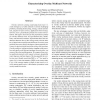Free Online Productivity Tools
i2Speak
i2Symbol
i2OCR
iTex2Img
iWeb2Print
iWeb2Shot
i2Type
iPdf2Split
iPdf2Merge
i2Bopomofo
i2Arabic
i2Style
i2Image
i2PDF
iLatex2Rtf
Sci2ools
ICNP
2003
IEEE
2003
IEEE
Characterizing Overlay Multicast Networks
Overlay networks among cooperating hosts have recently emerged as a viable solution to several challenging problems, including multicasting, routing, content distribution, and peer-to-peer services. Application-level overlays, however, incur a performance penalty over router-level solutions. This paper characterizes this performance penalty for overlay multicast trees via experimental data, simulations, and theoretical models. Experimental data and simulations illustrate that (i) the average delay and the number of hops between parent and child hosts in overlay trees generally decrease, and (ii) the degree of hosts generally decreases, as the level of the host in the overlay tree increases. Overlay multicast routing strategies, together with powerlaw and small-world Internet topology characteristics, are causes of the observed phenomena. We compare three overlay multicast protocols with respect to latency, bandwidth, router degrees, and host degrees. We also quantify the overlay tree ...
| Added | 04 Jul 2010 |
| Updated | 04 Jul 2010 |
| Type | Conference |
| Year | 2003 |
| Where | ICNP |
| Authors | Sonia Fahmy, Minseok Kwon |
Comments (0)

